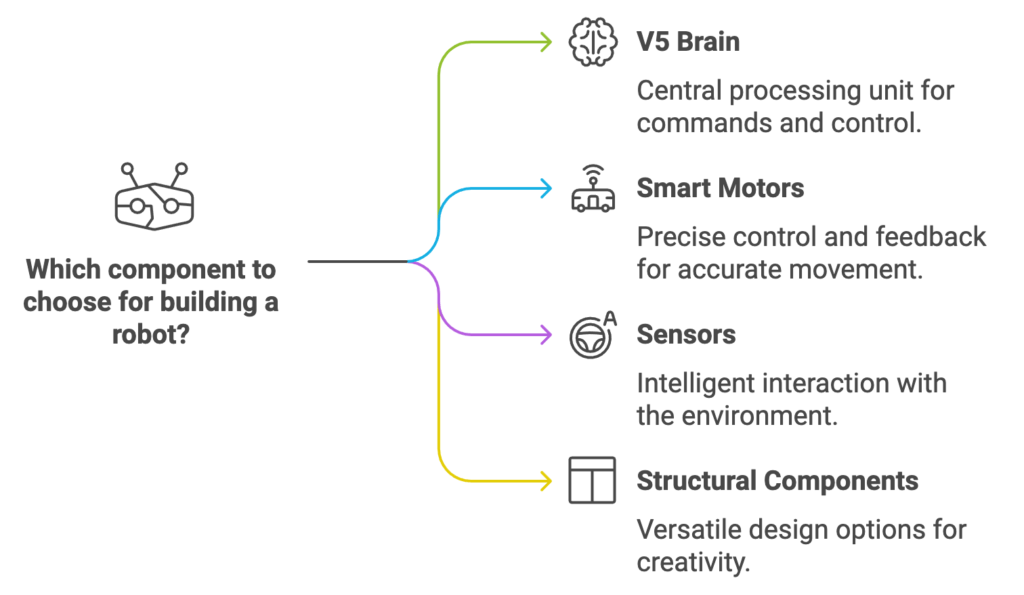Designed to promote competitive and instructional Robot Rally for the V5 System is a revolutionary platform. Designed to make robotics more approachable and interesting for students of all ages, it debuted in 2018. The V5 system has transformed how we approach robotics instruction and contests with its advanced sensors, strong motor controls, and flexible programming possibilities.
What is a Robot Rally?
Teams design and program robots to finish different challenges in the exciting Robot Rally. Usually organized as a tournament, competitors square off their robots’ performance in rounds. These demonstrations let students apply their academic knowledge in real-world scenarios, therefore promoting innovation, problem-solving, and teamwork.
Key Features of the V5 System
Hardware Overview
The V5 system boasts a robust hardware setup, including:
- V5 Brain: The core of the system, acting as the robot’s brain, processing commands and controlling motors and sensors.
- Smart Motors: Featuring built-in encoders for precise control, these motors offer feedback that allows for accurate movement and speed adjustments.
- Sensors: A variety of sensors, including vision sensors, gyroscopes, and distance sensors, enable robots to interact with their environment intelligently.
- Structural Components: The system provides a wide range of structural components, from metal beams to wheels, allowing for creative robot designs.

Software Capabilities
Programming environment of the V5 system is flexible and user-friendly. It supports several programming languages including VEXcode VR (for virtual robotics) and VEXcode (based on C++). These programming tools let users create sophisticated algorithms, therefore enabling robots to carry out jobs quickly.
Understanding the Robot Rally for the V5 System
Team Structure
Usually including three to five people, teams assign particular duties including programmer, builder, and strategist. This system guarantees that everyone uses their abilities, therefore promoting a more unified team effort.
Competition Rounds
Usually comprising several rounds, the Robot Rally pits teams against one another. Every round consists of chores for robots to finish include navigating obstacle courses, gathering objects, or gaining points by finishing particular objectives. Every round’s victors build points, which results in an event’s overall champion in the end.
Rules and Regulations
Design Specifications
The Robot Rally has particular design rules to guarantee equity. Robots have to follow weight and size restrictions; usually, they are not taller or heavier than a given height or weight to guarantee all teams have equal possibilities. Robots also have to be constructed using VEX components, so encouraging innovation in a controlled setting.
Scoring Criteria
Usually, the Robot Rally bases scoring on time taken, task completion success, and rule adherence. Every chore could have varied point worth, hence teams have to plan to get the best possible score.
Strategies for Success
Robot Design Tips
- Simplicity is Key: While it can be tempting to create a complex robot, simplicity often leads to greater reliability. Focus on core functions that are essential to completing the tasks.
- Modular Design: Building your robot in a modular fashion allows for easy adjustments and repairs. If one component fails, it can be quickly replaced without overhauling the entire robot.
- Testing and Iteration: Regularly test your robot throughout the build process. This iterative approach helps identify flaws early, allowing for timely adjustments.
Programming Strategies
- Start with a Clear Plan: Before coding, outline the specific tasks your robot needs to accomplish. This roadmap helps in structuring your code logically.
- Use Sensor Feedback: Incorporate sensors into your programming to make your robot responsive to its environment. For example, a distance sensor can help your robot avoid obstacles.
- Debugging: Expect to encounter bugs. Develop a systematic approach to debugging by testing each section of your code individually.
Common Challenges and Solutions
While participating in a Robot Rally can be thrilling, teams often face challenges. Some common issues include:
- Technical Failures: Malfunctions in motors or sensors can hinder performance. Regular maintenance and thorough testing can mitigate these risks.
- Communication Breakdowns: Clear communication among team members is crucial. Establishing roles and holding regular meetings can ensure everyone is on the same page.
- Time Management: Balancing building, programming, and practice can be challenging. Creating a timeline with milestones helps keep the team focused and organized.
Preparing for the Event
Practice Makes Perfect
Teams should schedule practice time before the tournament. Creating fictitious competitive events might help one get ready for the real one and point up areas needing work.
Team Coordination
Good collaboration can either strengthen or destroy the performance of a team. Establishing open lines of contact and routinely talking about tactics can help to improve team relations and cooperation.
Conclusion
Students have a fantastic chance to learn, create, and compete in the field of robotics by means of the Robot Rally for the V5 system. Participants can flourish in this challenging environment by knowing the subtleties of the V5 system, honing design and programming techniques, and collaborating powerfully as a team. Whether your experience level is fresh or seasoned, the Robot Rally provides a forum for investigating robotics’ delights, inventiveness, and problem-solving.

